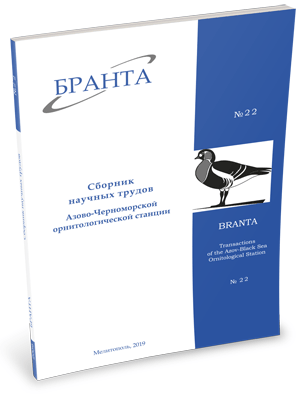
Transactions
of the Azov-Black Sea Ornithological Station



Morphometric parameters of waders' intestines (Charadrii) at migratory stopovers in the Azov-Black Sea region
I. O. Lykova, L. P. Kharchenko.
The features of the morphofunctional organization of the digestive system of waders (Charadrii) during migratory stopovers in the Azov-Black Sea region were investigated. The rich trophic base of the region contributes to the active feeding of waders and the rapid accumulation of fat. It has been established that the absorption of a large number of forages contributes to the plasticity of the digestive system of migrants. At migratory stopovers, the digestive system of waders quickly adapts to intensive nutrition and digestion, as evidenced by an increase in the total mass of the digestive system, which is due to an increase in the morphometric parameters of the stomach, liver and intestines.
The complex analysis of the morphometric parameters of the intestines of 16 species of waders using the trophic base of the Azov-Black Sea region was carried out. Analysis of the forage base of waders during migratory stopovers showed that all studied species of waders did not differ in the range of forages and the type of feeding. The results of morphometric studies of the intestines of waders confirm that they, as for most birds, are characterized by a shortened intestine. The length of the intestine exceeds the length of the trunk of the body in 2.2-4.8 times, the absolute length of the intestine depends on the size of the bird body.
Analysis of the morphometric parameters of the waders' intestines showed that its anatomical structure and relative dimensions correspond to the trophic specialization and feeding strategy of birds. It is established that the relative length of the duodenum is 11.97-24.15% of the total length of the intestine, the jejunum and ileum – 69.5-72.3%, respectively. The large intestine is represented by the rectum, the relative length of which is 2.8-9.3% of the total length of the intestine. In most of the studied species of waders, the caecum is 11.2% (G. gallinago) – 18.2% (C. alpina) of the total length of the intestine. In T. erythropus, the caecum is 4.6% of the total intestine length, with almost reduced caecum in T. glareola (2.1%) and T. nebularia (0.7%). The features in the structure of the cecum in Ph. pugnax – the presence of an ampoule-shaped extension in the area of the caecum were noted.
References:
- Chernichko, I. I. (2010). Characteristics of sex and age composition of Calidris alpine (Aves, Charadriiformes) migrating across Sivash. Vestnik Zoologii, 44 (5), 433–444. https://doi.org/10.2478/v10058-010-0029-3
- Chernichko, I. I. (2010). Waders species and migration at the Azov and Black Sea coasts of Ukraine. Proceedings of the Zoological Museum, 41, 154–209. [in Russian].
- Dobrinskiy, L. N. (1981). Dynamics of morpho-physiological features of birds. Moscow: Nauka. [in Russian].
- Kharchenko, L. P. & Kovtun, M. F. (2011). Patterns of morphological and functional organization of the digestive system of birds of various trophic specializations: anatomical and histological structure of the digestive system of wild birds. Ornithology, 36, 27–38. [in Russian].
- Kharchenko, L. P. & Lykova, I. A. (2012). Changes in the fatty acid composition of lipids in the tissues of the ruff male (Philomachus pugnax L.) at the transitional stopovers of the Azov-Black Sea region. Bulletin of Cherkasy University (Series “Biological Sciences”), 39 (252), 131–139. [in Russian].
- Kharchenko, L. P. & Lykova, I. A. (2014). Littoral invertebrates in waders’ nutrition at stopovers in the Azov-Black Sea region. Ecology and noosphereology, 25 (1-2), 69–82. [in Russian]. https://doi.org/10.15421/031407
- Kharchenko, L. P. & Lykova, I. O. (2013). Lymphoid structures of the waders’ (Charadrii) digestive tract. The Journal of V.N. Karazin Kharkiv National University. Series: biology, 17 (1056), 137–146. [In Ukrainian].
- Khomenko, S. V. (2003). Feeding ecology of Curlew Sandpiper, Calidris ferruginea, during spring stopover in the Sivash Bay (Ukraine). Vestnik Zoologii, 37 (2), 97–99.
- Kirikova, T. A. & Antonovsky, A. G. (2007). The use of feeding macrozoobenthos of Molochny Liman by waders during migration. Branta: Transactions of the Azov- Black Sea Ornithological Station, 10, 74-97. [in Russian].
- Kovtun, M. F., Lykova, I. O. & Kharchenko, L. P. (2018). The plasticity and morphofunctional organization of the digestive system of daders (Charadrii) as migrants. Vestnik Zoologii, 52 (5), 417–428. https://doi.org/10.2478/vzoo-2018-0043
- Kozlova, E. V. (1961).Charadriiformes. Waders. (Vol. 2). Fauna of the USSR. Birds. Moscow- Leningrad: Publisher of the USSR Academy of Sciences. [in Russian].
- Lakin, G. F. (1990). Biometrics. Moscow: High School. [in Russian].
- Lykova, I. O. (2012).Changes in fatty acid composition of lipids in tissues of different organs of waders in the pre-migration period. Branta: Transactions of the Azov-Black Sea Ornithological Station, 15, 94-101. [in Ukrainian].
- Lykova, I. O. (2014). Dynamics of digestive morphometric parameters of waders at migratory stopovers. Biology and valeology, 16, 29–36. [In Ukrainian].
- Lykova, I. O., Kovtun, M. F., Kharchenko, L. P. & Kratenko, R. I. (2019). Plasticity of digestive system of waders (Charadrii) as migrants (peculiarities of fat accumulation and the source of essential polyunsaturated fatty acids during migratory stops in the Azov-Black Sea region).Vestnik Zoologii, 53(4), 335–348. https://doi.org/10.2478/vzoo-2019-0032
- Zamoskovskiy, E. M. (1989). On the ratio of the length of the small intestine in birds of different types of nutrition. Intercollegiate Collection of Scientific Papers, 167-173. [in Russian].